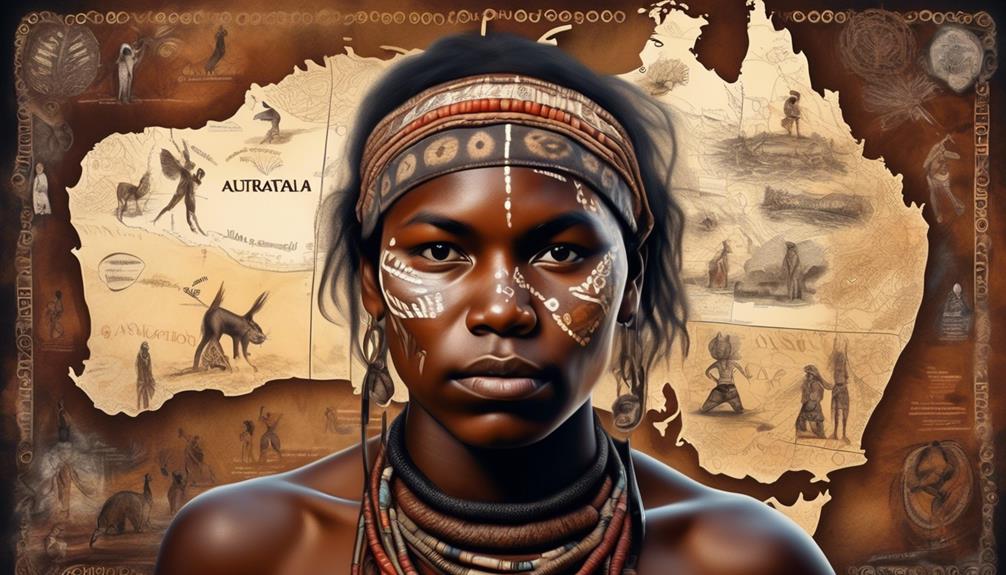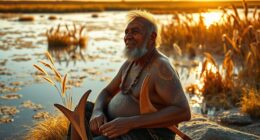Did you know that the Gathering of Nations, the largest powwow in North America, attracts over 3,000 dancers and 500 tribes from across the United States and Canada?
As a non-native individual, you may have wondered whether you are welcome to attend this culturally significant event.
The question of whether non-natives can participate in the Gathering of Nations is a complex one, deeply rooted in the history and traditions of Native American communities.
It's important to understand the nuances and considerations surrounding non-native attendance at this revered gathering.
Key Takeaways
- Non-natives are generally welcome to attend the Gathering of Nations.
- Cultural immersion involves actively seeking to understand and appreciate the traditions showcased.
- Non-natives should approach the experience with an open mind and a willingness to learn.
- Attending the Gathering of Nations can be a transformative experience, fostering personal growth and appreciation for Indigenous diversity.
Understanding the Gathering of Nations
If you've never been to the Gathering of Nations before, it's a vibrant and culturally rich event that celebrates Native American heritage and traditions. As a non-native attendee, it's important to approach the event with respect and an open mind.
The Gathering of Nations is a cultural celebration that brings together Indigenous peoples from across the Americas. It's a time to honor and showcase the diverse Native American traditions, including music, dance, art, and regalia.
The powwow, a central event at the Gathering of Nations, is a powerful display of Native American culture. It's a time for different tribes to come together, share their customs, and express their unique identities through dance and music. As a non-native visitor, it's essential to observe with reverence and appreciation for the significance of these traditions.
Take the opportunity to learn about the different dances, their meanings, and the regalia worn by the dancers. By doing so, you'll gain a deeper understanding of the rich heritage and traditions that are being celebrated.
History and Cultural Significance

The powwow, as a central event at the Gathering of Nations, holds deep historical and cultural significance for Indigenous peoples, serving as a vibrant display of their traditions and identities through music and dance. This cultural celebration is a time-honored tradition, rooted in the rich history of Indigenous peoples. The powwow is a gathering that provides an opportunity for Indigenous communities to come together, reconnect with their heritage, and share their customs with others. It serves as a powerful expression of Indigenous traditions, fostering a sense of unity and pride among participants.
The Gathering of Nations powwow is a testament to the resilience and strength of Indigenous cultures, as it has persevered through centuries of adversity. The rhythmic drumming, intricate regalia, and spirited dances all symbolize the endurance of Indigenous traditions and the preservation of their cultural heritage. The event not only honors the past but also carries the legacy of Indigenous peoples into the future, ensuring that their rich traditions remain vibrant and celebrated.
It stands as a testament to the enduring spirit of Indigenous communities and the powerful significance of their cultural practices.
Admission and Participation for Non-Natives
While non-native individuals are welcome to attend and participate in the Gathering of Nations, it's important to respectfully engage with and honor the traditions and customs of the Indigenous peoples hosting the event. When considering admission requirements and cultural immersion, it's essential to approach the Gathering of Nations with a deep respect for the Native American culture and heritage.
Here's what you need to know:
- Admission Requirements
- Non-natives are generally welcome to attend the Gathering of Nations, but it's crucial to check if there are any specific admission requirements or protocols to follow. This could include obtaining tickets in advance, registering for certain activities, or adhering to specific guidelines during the event.
- Cultural Immersion
- Embracing cultural immersion involves actively seeking to understand and appreciate the traditions, dances, music, and arts showcased during the Gathering of Nations. It's important to approach this experience with an open mind and a willingness to learn from the Indigenous peoples, ensuring that you participate in a respectful and meaningful manner.
Respectful Engagement and Etiquette

To engage respectfully with the traditions and customs of the Indigenous peoples at the Gathering of Nations, it's important to understand and adhere to the etiquette and protocols governing your interactions and participation.
Cultural sensitivity is paramount when engaging with Indigenous communities. It's crucial to approach social interactions with humility and a willingness to learn. When attending the Gathering of Nations, it's essential to be mindful of the cultural significance of various practices and ceremonies.
Show respect by seeking permission before taking photographs or participating in any rituals. Additionally, active listening and observing proper behavior in communal spaces are integral to demonstrating respect.
Engaging in meaningful conversations with Indigenous individuals can provide valuable insights into their traditions and perspectives, but it's essential to approach such interactions with sensitivity and an open mind.
Impact and Takeaways for Non-Native Attendees
As a non-Native attendee, consider reflecting on the profound impact and meaningful takeaways from your experience at the Gathering of Nations. Attending such an event provides a unique opportunity for cultural exchange and cross-cultural learning. Here are some key points to reflect on:
- Cultural Exchange:
- Engaging with diverse Indigenous cultures can broaden your understanding of different traditions, languages, and customs.
- Immersing yourself in traditional dances, music, and art can foster a deeper appreciation for the rich heritage of Indigenous communities.
- Cross-Cultural Learning:
- Interacting with Native attendees can offer insights into their historical experiences and contemporary challenges, fostering empathy and understanding.
- Observing and participating in ceremonial practices can provide a deeper understanding of the spiritual and communal aspects of Indigenous cultures.
Attending the Gathering of Nations as a non-Native individual can be a transformative experience, offering opportunities for personal growth and fostering a greater appreciation for the diversity of Indigenous peoples. It's essential to approach the event with an open mind and a respectful attitude, seeking to engage in meaningful cultural exchange and cross-cultural learning.
Frequently Asked Questions
Are Non-Natives Allowed to Participate in the Traditional Dances and Ceremonies at the Gathering of Nations?
Yes, non-natives can participate in the traditional dances and ceremonies at the Gathering of Nations. Participation eligibility is open to all who want to learn and respect the culture.
It's a valuable cultural exchange opportunity for everyone involved. By engaging respectfully and with an open mind, non-natives can contribute to the rich tapestry of the event and foster understanding and appreciation of indigenous traditions.
Can Non-Natives Purchase and Wear Traditional Regalia or Attire at the Event?
Yes, non-natives can purchase and wear traditional regalia at the event.
However, it's important to approach this with respect and understanding of the cultural significance.
When participating in cultural activities, it's essential to do so in a way that honors and respects the traditions and beliefs of the Native communities.
Engaging in cultural participation with sensitivity and openness can lead to a meaningful and enriching experience for all involved.
Are Non-Native Vendors and Artisans Allowed to Sell Their Products at the Gathering of Nations?
Non-native participation at the Gathering of Nations isn't just allowed, it's encouraged! Vendors and artisans from all backgrounds are welcome to showcase their products and contribute to the cultural exchange. The event is a celebration of diversity and unity, so your presence and contributions as a non-native vendor or artisan would be valued.
It's a fantastic opportunity to share and learn from each other's traditions and crafts. Get ready to be a part of something truly special!
Is There a Specific Protocol for Non-Natives to Follow When Interacting With Native Elders and Community Members at the Event?
When interacting at the Gathering of Nations, it's essential to understand and follow the cultural respect protocol.
Show respect by listening attentively, asking permission before taking photos, and refraining from touching sacred items without permission.
Approach conversations with an open mind and willingness to learn.
Remember to address elders and community members with the proper titles and express gratitude for their wisdom.
Your respectful behavior fosters positive interactions and mutual understanding.
Are There Any Specific Ways Non-Native Attendees Can Support and Contribute to the Cultural Preservation and Empowerment Efforts of Indigenous Communities at the Gathering of Nations?
To support cultural preservation and empower indigenous communities at the Gathering of Nations, non-native attendees can participate in educational workshops, buy authentic crafts directly from indigenous artisans, and respectfully engage with cultural activities.
By learning about and respecting indigenous traditions, supporting indigenous-owned businesses, and amplifying indigenous voices, you can contribute to the preservation and empowerment of indigenous communities.
Your active involvement and genuine support help uplift and honor indigenous cultures.
Conclusion
So, if you're considering attending the Gathering of Nations as a non-native, go for it!
Immerse yourself in the rich cultural experience and connect with Indigenous communities.
Just remember, when in Rome, do as the Romans do.
Show respect, be open-minded, and embrace the opportunity to walk in someone else's moccasins.
You'll come away with a new perspective and a feather in your cap.
Mary is a passionate writer who brings creativity and a fresh perspective to our team. Her words have the power to captivate and inspire, making her an essential contributor to our content. Mary’s commitment to storytelling and dedication to promoting Indigenous culture ensures that her work touches the hearts of our readers. We’re fortunate to have her as part of our team.










